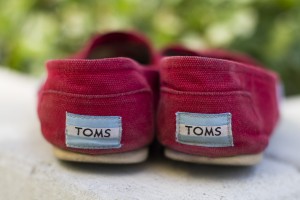
Brands like TOMS Shoes and RIPEBRAND have come out of the woodwork recently as companies with a cause.
With these new trends emerging, many BYU students wonder if supporting causes through purchases is philanthropy or just a fashion fad.
Several companies have shared the stories behind their labels, stories of charitable giving and corporate responsibility. But BYU students have both mixed feelings about cause-related fashion and different motivations for their shopping habits. Many students said they buy brands because they are fashionable and the charity giving behind the items is usually only a perk.
Addison Wimmer, an advertising major from Orem, said she likes having brands that support charities, but she wonders if her purchases are really making a difference.
“I think it’s important to support a company with a cause if they actually come through with that cause,” Wimmer said. “But it makes you wonder if what they’re doing is what they say they’re doing.”
Wimmer got a pair of TOMS as a gift and said she liked the cause behind it, but ultimately, style was the deciding factor. She said she thinks students share her opinion of fashion over philanthropy.
“I think the first priority is that it’s fashionable and they want to go with what everybody else is doing,” Wimmer said. “But the second reason they are doing it is because they want to say they helped the cause.”
However, Wimmer said she personally loves the causes companies support and would pay some extra money for a brand that gave back to the community as opposed to one that did not.
“It makes you feel better about what you are buying because it makes you feel like you are helping someone else out in the process,” Wimmer said.
McCall Pitcher, a history major from Park City, said students who buy labels that give back do so for a quick gratification of doing the right thing.
“I think it makes people feel better because it’s a fast way to feel like you’re helping out,” Pitcher said.
Pitcher said she bought her pair of TOMS shoes more for style than for the cause. She said she was fairly skeptical of certain brands because she thinks many companies use causes as a good market strategy to get people to buy their product.
“People should be more concerned where they give their money,” Pitcher said. “They should give to causes they can trust.”
Many organizations want to bridge the gap of consumer trust in their causes. One such company is RIPEBRAND, which seeks to give back to local non-profits and build lasting relationships between the community and charitable organizations. RIPEBRAND wants to fuse fashion and causes together through the sale of T-shirts that stand for a cause.
“We are committed to bring awareness and opportunities for local non-profits,” said Nick Chang, founder of RIPEBRAND. “We are committed to three main causes: youth, health and property.”
With so many companies vying for consumers to back up their causes, many students find it hard to know which brands to trust. Many companies want to set themselves apart from business that simply use causes as advertising, but students will ultimately decide what causes they are willing to pay extra for at the register.




